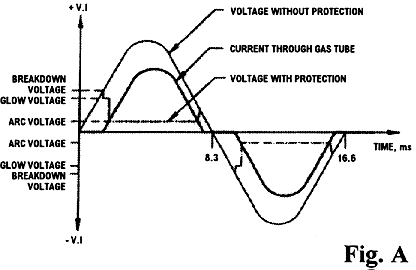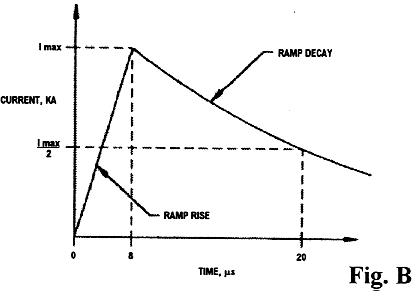


| Gas discharge tubes consist of two or more metal electrodes held close to each other by highly insulating material. The space between the electrodes is hermetically sealed with a suitable mixture of gases at low pressures. The space between and shape of the electrodes, the nature of the surface treatment of the electrodes and the gas pressure determine the breakdown voltage of the gas tubes. By controlling one or more variables, gas tubes can be made with breakdown voltages as low as 75 volts to as high as many thousands of volts. TII makes gas tubes of different designs and configurations that are suitable for various applications. All the gas tubes made by TII are of premium quality and employ no radioactive or other environmentally hazardous material. | |
| Gas tubes are used to protect electrical equipment from disturbances on DC circuits, signal circuits and power lines. The disturbances can be due to switching of electrical equipment or lightning strokes impressed directly or due to induction. The gas tubes function as overvoltage crowbar devices. In the normal operation of the equipment gas tubes are transparent to the functioning of the system, but whenever the voltages exceed the breakdown voltage of the gas tube it goes into conduction mode, diverting the surge energy away from the equipment being protected. | |
| In order to understand the functioning of a gas tube we could consider a sine wave impressed on its terminals. As the voltage of the sine wave increases from zero to a voltage that causes the ionization process inside the gas tube to begin, the gas tube goes into conduction mode. The gas tube does not go into high conduction mode, usually termed as arc mode, right away. First it goes into low current conduction mode called glow mode. If the signal source provides sufficient current, more charge will flow, giving rise to avalanche effect. At that time the gas tube will go into high current conduction or arc mode. The voltage between electrodes during glow mode is called glow mode voltage. Similarly the voltage in arc mode is called arc voltage. The gas tube will stay in conduction mode as long as the signal source is able to maintain sufficient current through the tube. In the AC cycle being investigated, the voltage increases to a maximum and then falls to zero to complete a half cycle. As the voltage falls from peak of the AC cycle to low voltage, current at some stage will not be able to sustain arc voltage. At that instant the gas tube will revert to non conduction mode. The gas tube will exhibit similar behavior during the negative half cycle of the AC impressed across its terminals. | |
| The gas tube will go into conduction mode when impressed by any high voltage impulse wave form. When voltage of the impulse rises to the breakdown voltage of the gas tube, it will go into conduction mode; first into glow mode and later into arc mode. The gas tube will stay in the arc mode as long as the impressed voltage is higher than the arc voltage and the current flowing through the tube is greater than the arc sustaining current called the holdover current. In the tele-communication networks where DC biasing of the system is greater than the arcover voltage of the gas tube, the holdover current and time are important in the selection of the suitable protection element. | |
|
|
|
| Various wave forms are used in qualifying gas tubes for specific applications. One common wave form for high energy surge handling capability of gas tubes is the 8/20 microsecond current wave form. This wave rises to its maximum specified current in 8 microseconds, followed by a decay to half of maximum value in 20 microseconds from the beginning of the wave form. The maximum surge handling capability of a gas tube is judged from the value of the 8/20 microsecond wave that it can sustain without getting aerated. | |
|
| |
| Another commonly specified wave form is 10/1000 microsecond wave form. This current wave form reaches its peak in 10 microseconds and decays to half of its peak current value in 10000 microseconds from the start of the wave form. Since this wave form is not as severe as the 8/ 20 micro second wave form, surge life of a gas tube is established from the number of surges of certain short circuit current of 10/1000 microsecond wave a gas tube can survive without getting out of specified limits. | |
|
|
|